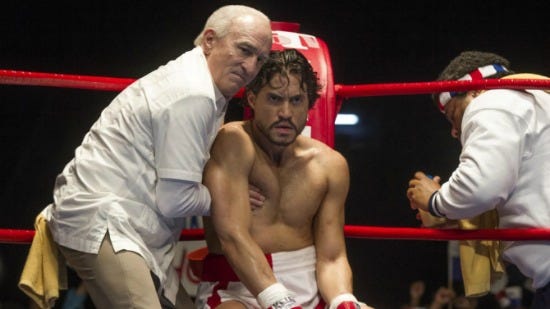Hands of Stone

“Hands of Stone” gets by on the power of its performances and the lifelike depiction of Roberto Duran’s fighting style in the boxing ring. Like a lot of biopics, it stumbles when trying to shoehorn a long, complicated life into a 105-minute story.
For instance, the movie covers Duran’s early career from brawler in the streets of Panama to his 1983 comeback fight against a young Davey Moore, after the humiliation of his infamous “No Mas” rematch with the great Sugar Ray Leonard, in which he relinquished the title by refusing to fight anymore.
In fact, Duran had already lost a couple other “comeback” fights before that one, and would continue to fight for nearly three decades after — including a third bout with Leonard in 1989 (which he also lost).
Still, I can understand why writer-director Jonathan Jakubowicz, a Venezuelan making his English-language feature film debut, chose to cut the string of this story thread where he did. Boxing movies tend to follow a familiar rise /fall / rise again three-act story structure, and you know what they say about that which ain’t broke. It makes the movie predictable, but also more digestible.
Edgar Ramírez, almost 40, shines playing Duran from about 19 to age 32. He’s much prettier than the real Duran, but that’s Hollywood for you. Ramírez gives him a sort of feral charm, a street urchin who fought bare knuckles for cash turning into the hungry young boxer who stalked his opponents like a beast of prey in the ring.
When he spots a pretty young schoolgirl, Felicidad (Ana de Armas), he corners her and proposes marriage on the spot. Here was a man who knew real craving in life, so when he saw the things he wanted, he pounced.
Robert De Niro is in his usual fine form as Ray Arcel, a legendary trainer who was pushed out of the game 18 years earlier when he defied Frankie Carbo (John Turturro), a New York mobster who controlled the fights. Nearly killed, he promised never to make another dollar in the ring. So he agreed to train Duran for free.
Usher Raymond (using his full name here) shines as Leonard, who is depicted as a lightning-fast fighter with loads of charm and wit. Goaded by Duran to “fight like a man” in their first bout, he smiled after losing because he knew he had been outsmarted. By the time their rematch came a few months later, Leonard was a honed blade while Duran had let himself get badly out of shape.
There’s an interesting tension here between Duran, Arcel and Carlos Eleta (Ruben Blades), the wealthy Panamanian businessman who bankrolled Duran. Arcel, who seems himself as much as a father to his fighters as a trainer, sees nothing wrong with letting Duran take some time off, eat whatever he wants, and enjoy what he’s earned. But Eleta, sensing a big payday, sees money as more important than winning.
De Niro’s character imparts a lot of wisdom, both in the ring and in the narration. He differentiates between tactics, which are a fighter’s moment-by-moment decisions in the ring, with strategy, which is the long-term plan of how to outmaneuver your opponent. Arcel also employs little idiosyncratic moves, like combing Duran’s hair before each round, so he seems fresh and invincible.
Jakubowicz goes for a moderate blend of styles for the fight scenes, eschewing the ridiculousness of the “Rocky” movies — where guys absorb haymaker after haymaker without going down — and the lyrical slo-mo blood sport of “Raging Bull” and its ilk. The boxing is straightforward and deliberate, with enough “flash bulb” moments for the audience to grasp the impact of the blows.
In boxing parlance, “Hands of Stone” has punching power but a poor sense of timing. The story dances here and there, skipping over most of the 1970s and then rushing the final act. It’s a worthy picture, but destined to remain a contender.



